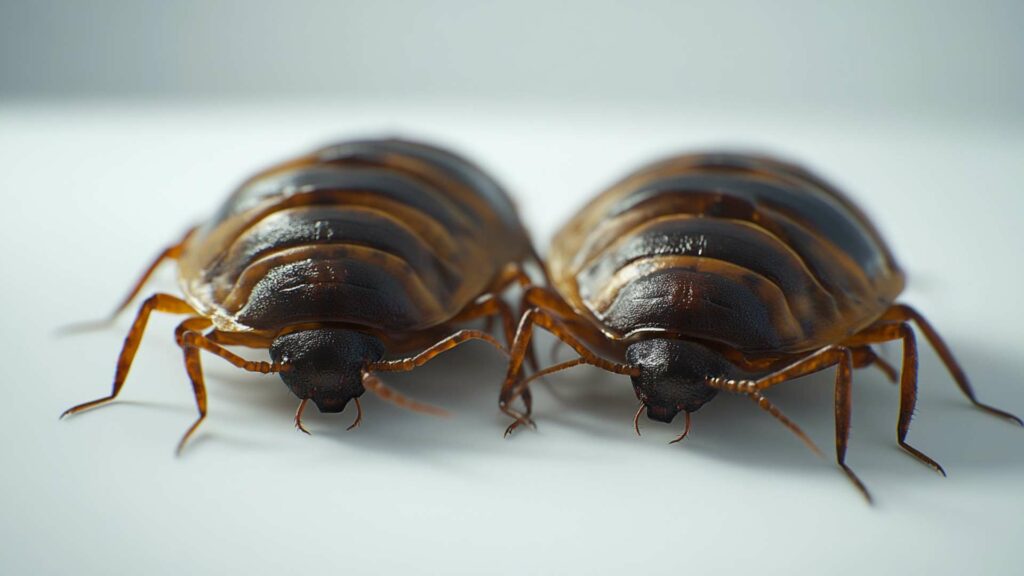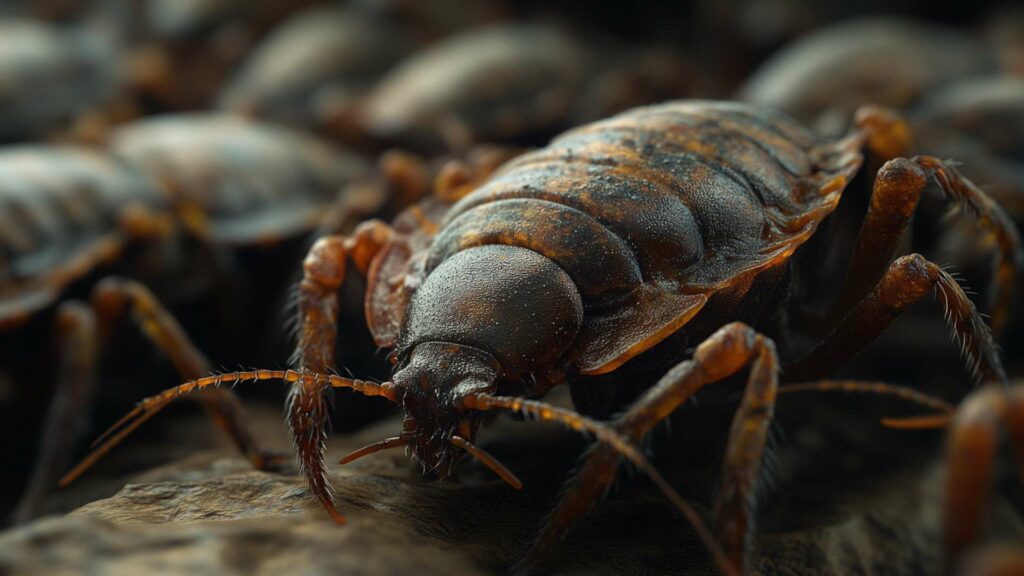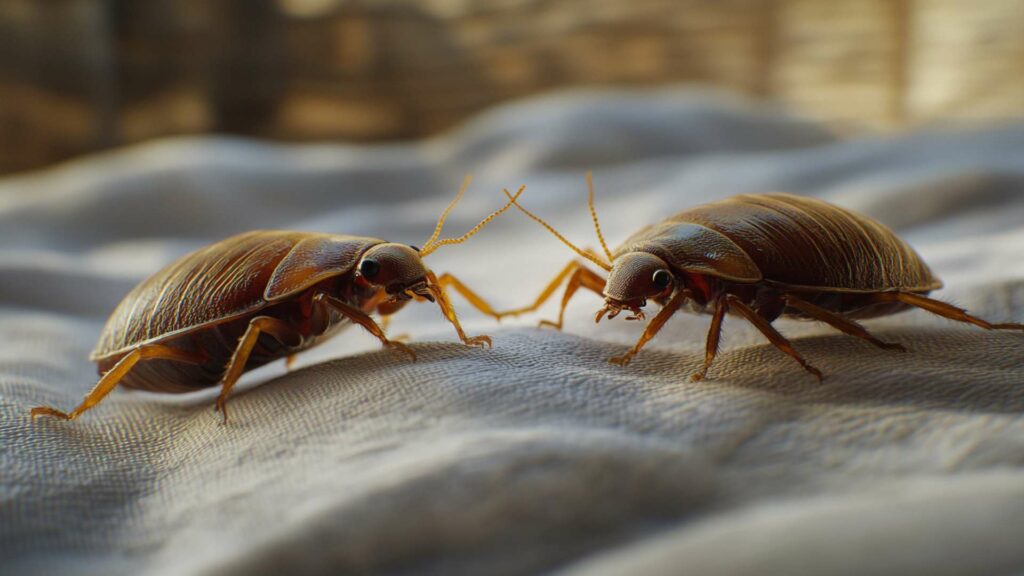The Tiny Vampires of the Night: Bed Bugs and Their Sneaky Bites
A Brief Overview of Bed Bugs and Their Bites
Imagine settling down for a peaceful night’s sleep in a cozy hotel room, only to wake up covered in itchy, red welts. You inspect your bed and discover unwelcome intruders—bed bugs! These minuscule, apple seed-sized creatures are not only nocturnal but also skillful hitchhikers.
They can easily latch onto luggage or clothing, making their way into our homes without us even realizing it. Despite their name, bed bugs aren’t confined to beds; they can lurk in various hiding spots such as box springs, loose wallpaper, or secondhand furniture.
The bites inflicted by these blood-sucking pests can cause quite an annoyance. Unlike mosquito bites that tend to be more random and scattered, bed bug bites often appear in clusters or linear patterns on exposed areas of skin.
While each individual’s reaction to bed bugs and spider bites, may vary, common symptoms include redness, swelling, and severe itching. However, some unfortunate souls might experience more severe reactions leading to complications such as skin infections.
Stay Informed, Stay Safe: Knowledge is power when it comes to bed bug health concerns. Explore our article on Bed Bug Health Concerns to understand the implications and make informed decisions to protect yourself and your loved ones.
Unveiling the Mystery: Allergic Reactions to Bed Bug Bites

Why do some people have stronger allergic reactions to bed bug bites than others? The answer lies within the saliva of these tiny parasites.
When a bed bug pierces our skin with its elongated mouthpart (proboscis) to feed on our blood for several minutes unnoticed, it injects its saliva into the wound. This saliva contains various proteins that act as anticoagulants and anesthetics which prevent our bodies from detecting their presence immediately.
For individuals with heightened sensitivity or allergies to certain components found in the saliva of these bloodthirsty critters, an immune response is triggered. This response can result in the release of histamines, causing localized inflammation and itching.
Common allergic reactions to bed bug bites include redness, swelling, and a persistent urge to scratch the affected area. Unfortunately, this incessant scratching can break the skin and increase the risk of secondary infections.
Can You Outsmart These Stealthy Intruders?
Now that we’ve gained some insight into bed bugs and their bites, it’s crucial to learn how to prevent their unwelcome presence in our lives. Prevention is undoubtedly better than dealing with the aftermath of these pesky pests feasting on our blood while we sleep peacefully.
To prevent bed bug bites while traveling, inspect your hotel room thoroughly upon arrival. Look for telltale signs such as bloodstains on sheets, dark spots (bed bug excrement), or even live bed bugs found hiding in mattress seams or crevices.
Use luggage racks or keep your bags elevated off the floor to minimize the risk of hitchhiking bed bugs finding their way into your belongings. At home, regularly vacuuming mattresses, box springs, and sofa cushions can help eliminate any potential hiding spots for these elusive creatures.
Consider using mattress encasements that are designed specifically for bed bug protection. Additionally, when purchasing secondhand furniture, carefully examine it for any signs of a hidden bed bug infestation before bringing it indoors.
By understanding more about these tiny vampires and taking proactive measures to prevent them from infiltrating our spaces, we can reduce our chances of experiencing those agonizingly itchy bed bug bites that leave us scratching for days on end. Stay vigilant and don’t let these sneaky pests disrupt your peaceful slumber!
Understanding Bed Bug Bites
The Sneaky Culprits: Description of Bed Bug Bite Appearance and Symptoms
Have you ever woke up one morning only to discover small, itchy red bumps on your skin? Chances are, you may have fallen victim to those stealthy little pests known as bed bugs.
Bed bug bites can be quite deceptive about the size, as they often resemble other common insect bites like mosquito bites. These tiny welts might appear in clusters or a linear pattern on exposed areas of your body, such as arms, legs, or even your face if you unwittingly came into contact with these nocturnal nuisances while sleeping.
Unlike flea bites that tend to be concentrated around the ankles and lower legs, bed bug bites can occur anywhere there is exposed skin during sleep. Physical signs of bed bug bites include redness, swelling, and intense itching at the bite site.
The skin surrounding the bite might also show signs of inflammation or become blistered. One characteristic feature that sets bed bug bites apart from other insect bites is their tendency to form a line or a cluster due to the bugs’ feeding behavior.
A Midnight Feast: How Bed Bugs Feed on Human Blood
You may wonder how these pesky insects manage to feast on human blood undetected. Well, let’s shed some light on their cunning feeding strategy!
Bed bugs are attracted by the carbon dioxide we exhale when we sleep and find their way toward us using their keen sense of smell. Once they reach our exposed skin surface, they insert their sharp mouthparts into our flesh to access blood vessels beneath.
Feeding time for bed bugs can range from five to ten minutes per individual bite. To prevent us from feeling their piercing bite right away (unlike mosquitoes), they inject a small amount of anesthetic substance through their saliva into our skin before sucking out blood.
This saliva also acts as an anticoagulant, keeping the blood flowing freely while they feed. It is this saliva that often triggers allergic reactions in some individuals, leading to itching, redness, and other discomforting symptoms.
While young bed bugs (nymphs) require a blood meal to molt and grow, adult bed bugs can survive for several months without feeding. However, when given the opportunity, they will gladly indulge in a midnight feast on our unsuspecting selves.
So next time you find yourself scratching those itchy bites on your arms or legs, remember that it’s not just their physical presence that makes bed bugs infuriating – it’s also their feeding habits that can leave you scratching your head in frustration. Read it here to learn more about bed bugs travel and bug bites symptoms and treatment options.
Common Allergic Reactions to Bed Bug Bites
The Itchy Dilemma: Scratching the Surface
When it comes to bed bug bites, itching is the most common complaint among those affected. As the tiny insects feast on our unsuspecting skin, they inject an anticoagulant to prevent blood clotting during their meal.
This invisible intruder triggers a histamine response in our bodies, leading to irresistible itching sensations. Soon enough, we find ourselves scratching away at the bite marks with an itchiness comparable to mosquito bites.
The problem is, this incessant scratching can cause further irritation and potentially lead to secondary infections. Thus, it’s crucial to resist the temptation and seek proper relief.
Seeing Red: The Telltale Signs of Inflammation
In addition to itching, bed bug bites often manifest as redness and inflammation around the affected area. These symptoms are a result of our immune system’s response, which releases chemicals like histamine and prostaglandins that cause blood vessels near the bite site to dilate and become more permeable. While some individuals may experience a milder reaction with bed bug bites affect with only minor redness resembling flea bites or initial mosquito bites, others may develop larger welts or papular rashes resembling hives due to increased sensitivity.
The Delayed Hypersensitivity Enigma
One intriguing aspect of allergic reactions to bed bug bites is their delayed hypersensitivity nature. Unlike other allergies that often trigger immediate responses from the immune system upon exposure, bed bug bite reactions can take hours or even days before becoming apparent.
This delayed onset can lead people initially unaware that they’ve been bitten by these sneaky bugs since they might not notice any immediate symptoms after being fed upon during sleep in infested environments like dorm rooms or upscale five-star hotels. It’s important to note that while common allergic reactions to bed bug bites typically involve itching, redness, and inflammation, these symptoms can vary from person to person.
Factors such as individual immune system responses, the number of other bug bites received, and sensitivity levels all contribute to the severity of the reaction. If you suspect bed bugs are the culprits behind your bite marks, it’s essential to take appropriate measures to treat the symptoms while also addressing the underlying infestation issue to prevent further encounters with these nocturnal nuisances.
The Dreaded Anaphylaxis: When Bed Bug Bites Turn Life-Threatening

Definition and explanation of anaphylaxis about bed bug bites
Anaphylaxis, a term that strikes fear in the hearts of allergy sufferers, can also be triggered by severe reactions to bed bug bites. It is a potentially life-threatening allergic reaction that occurs when the body’s immune system goes into overdrive in response to an allergen.
In this case, the allergen is the saliva injected by bed bugs while they feed on human blood. When a person with heightened sensitivity to bed bug bites is bitten, their immune system releases large amounts of histamine and other chemicals into the bloodstream.
This sudden surge triggers a cascade of symptoms throughout the body, leading to anaphylaxis. While anaphylactic reactions are relatively rare compared to milder allergic responses, they must be taken seriously due to their potential severity.
Discussion on life-threatening symptoms, including difficulty breathing and swelling
Anaphylactic reactions caused by bed bug bites can manifest through various physical signs and symptoms. One of the most alarming indicators is difficulty breathing – caused by swelling in the throat or airways. This can lead to wheezing, shortness of breath, or even complete respiratory distress if left untreated.
Swelling is another prominent symptom during anaphylaxis. It typically affects areas surrounding the initial bite site but can spread rapidly throughout the body.
Notably, facial swelling can be particularly distressing as it may impair vision or even result in facial disfigurement temporarily. In addition to respiratory and swelling issues, individuals experiencing anaphylaxis may also exhibit other systemic reactions such as dizziness or lightheadedness due to lowered blood pressure.
Rapid heartbeat and hives all over their body are common as well – both indicative of a severe allergic response. It is crucial to remember that anaphylaxis can progress rapidly, and any signs of these symptoms should be treated as a medical emergency.
Remember, while bed bug bites are usually harmless and cause nothing more than severe itching or redness, some individuals may experience severe allergic reactions that culminate in anaphylaxis. Being vigilant about potential signs and symptoms is crucial as prompt medical attention is essential when dealing with this life-threatening condition.
Factors Influencing Allergic Reactions to Bed Bug Bites
Genetic Predisposition to Allergies: Unraveling the Inheritance
Bed bug bites can trigger allergic reactions, and your genetic makeup plays a significant role in determining how your body responds to these pesky insects. Just as some individuals inherit traits like eye color or height from their parents, they may also inherit a predisposition for allergies.
If you have a family history of allergies, such as hay fever or asthma, you may be more likely to experience an allergic reaction to bed bug bites. The genes responsible for allergic reactions are complex and interconnected, involving various immune system components.
Certain genetic variations can make some individuals more susceptible to developing allergies in general, while others may have a heightened sensitivity specifically to the bed bugs bite and bug saliva. When bitten by bed bugs, these individuals may exhibit more intense allergic symptoms compared to those without this genetic predisposition.
The Immune System’s Role: Warriors Against Bed Bug Bites
Your immune system acts as the frontline defense against foreign invaders that enter your body, including allergens present in bed bug bites. When you are bitten by these tiny bloodsuckers, your immune system recognizes the proteins in their saliva as potential threats and mounts an attack. Individual immune system responses vary widely among people.
Some individuals possess robust immune systems that efficiently neutralize the allergens present in bed bug saliva before they can cause an overreaction. On the other hand, those with weaker or overly sensitive immune systems may experience more severe allergic reactions to bed bugs.
Additionally, repeated exposure to bed bug bites can influence how your immune system responds over time. If you frequently encounter these unwelcome guests due to a persistent infestation in your home or frequent travels where they lurk (even five-star hotels are not entirely safe!), your immune system might become hypersensitive and react more strongly to subsequent bites.
The Intricate Dance: Genes and Immune System Interplay
The relationship between genetic predisposition and individual immune system response is a fascinating and intricate dance. While genetics can provide the foundation for allergic reactions, the individual immune system ultimately determines the severity of these reactions. Imagine your genes as the blueprint for your immune system’s construction, determining its overall functionality.
However, it’s important to note that genetic predisposition does not guarantee allergic reactions nor dictate their intensity. The interplay of genes, environmental factors, and your immune system’s unique response all contribute to the final outcome.
Understanding these factors can help shed light on why some people may experience mild itching or redness from bed bug bites while others endure more pronounced symptoms like severe swelling or even anaphylaxis. By unraveling this complex web of genetics and immunity, we gain crucial insights into how allergic reactions to bed bug bites manifest differently in individuals.
Remember, prevention is key when it comes to bed bug infestations. Knowing how to avoid these resilient creatures can save you from potential allergic reactions and sleep deprivation caused by their unwelcome presence.
Treating Allergic Reactions to Bed Bug Bites

Relief and Healing for Itchy Skin
When you discover those telltale bed bug bites, one of the first steps in self-care is to wash the affected area with soap and water. This simple act helps to cleanse the skin and remove any potential irritants. Remember to use lukewarm water, as hot water can aggravate itching further.
Gently pat dry the area with a clean towel afterward. To alleviate the discomfort caused by bed bug bites, applying topical corticosteroids can work wonders.
These over-the-counter creams or ointments are specifically formulated to reduce inflammation, redness, and itching associated with allergic reactions. Be sure to carefully follow the instructions on the packaging and only apply the corticosteroid to intact skin.
Seeking Medical Attention for Severe Allergic Reactions
In some cases, bed bug bites can trigger severe allergic reactions that require immediate medical attention. If you experience symptoms such as difficulty breathing, swelling of the face or throat, dizziness, or a rapid heartbeat after being bitten by bed bugs, it’s crucial not to delay seeking help from a healthcare professional.
Severe allergic reactions known as anaphylaxis can be life-threatening if left untreated. Medical experts are equipped with the necessary tools and knowledge to provide appropriate interventions like epinephrine injections that can counteract severe symptoms effectively.
Prevention Tips for Avoiding Bed Bug Allergies
Strategies for Preventing Bed Bug Infestations
Prevention is always better than cure when it comes to bed bugs. To safeguard your home or hotel room from infestations, consider taking proactive measures to find bed bugs, such as regularly inspecting your sleeping quarters for signs of these unwanted visitors.
Look out for physical signs of bed bugs, like bite marks on your body, small dark spots on bedding or furniture, or even the bugs themselves. To prevent bed bugs from infiltrating your living space, it’s crucial to maintain a high level of cleanliness.
Regularly vacuuming carpets, upholstery, and mattresses can help eliminate any potential hiding places under bed frames. Additionally, sealing cracks and crevices around baseboards and furniture can create a barrier that prevents bed bugs from entering your home.
Suggestions for Minimizing Exposure to Bed Bugs while Traveling
When traveling, taking precautions against bed bug encounters is equally important. Before settling into your hotel room, inspect the bedding thoroughly for any signs of infestation.
Check the seams and corners of mattresses and box springs for small brownish stains or shed exoskeletons. If you do discover evidence of bed bugs or suspect an infestation, request a new room immediately.
To further minimize exposure to these pests while traveling, consider keeping your luggage elevated off the floor on a luggage stand or rack rather than placing it directly on upholstered furniture. Additionally, using plastic zippered bags for storing clothes during your trip can act as an extra layer of protection against potential hitchhiking bed bugs.
Lesser-known Facts about Bed Bugs and Allergies
Research Findings on the Correlation between Asthma Development and Bed Bug Allergies
Recent studies have shown a possible link between exposure to bed bug allergens and the development of asthma in some individuals. While more research is needed to fully understand this connection, it is believed that prolonged exposure to bed bug saliva or feces may trigger respiratory issues in susceptible individuals.
Understanding this correlation highlights the importance not only of treating existing infestations but also preventing them in the first place. By effectively managing bed bug populations through proactive measures like regular inspections and professional pest control when necessary, we can potentially improve respiratory health outcomes.
Uncommon Symptoms that May Occur due to Severe Allergic Reactions
In some rare cases, severe allergic reactions to bed bug bites can lead to more than just physical signs like redness and itching. Some individuals may experience psychological distress, such as anxiety or difficulty sleeping, as a result of the trauma associated with these infestations. It is important to approach these situations with empathy and seek professional support if needed.
By acknowledging the potential impact on mental well-being alongside physical health, we can foster a holistic understanding of the effects of bed bug allergies. This comprehensive perspective promotes comprehensive care for those affected by these pests and encourages a more compassionate approach to dealing with infestations.
Conclusion
As we navigate the intricacies of allergic reactions to bed bug bites, it becomes evident that addressing both prevention and treatment is crucial in ensuring our well-being. By employing self-care measures to treat bed bug bites, such as washing affected areas and using topical corticosteroids, we can find relief from itching and promote healing. However, when faced with severe allergic reactions, seeking immediate medical attention is paramount for our safety.
Furthermore, adopting preventive strategies like regular inspections and maintaining cleanliness helps steer clear of bed bug infestations in our living spaces. When traveling, vigilance is key in minimizing exposure to these pesky insects by thoroughly inspecting hotel rooms and taking precautions against their unwanted presence in our luggage.
Understanding lesser-known facts about bed bugs and allergies sheds light on the complexities surrounding their impact on our health. From potential links between allergies and asthma development to recognizing uncommon symptoms beyond physical signs, comprehensive knowledge empowers us to address these issues holistically.
Remember: while encountering bed bugs may be distressing, knowledge equips us with the tools needed to prevent their spread or effectively manage infestations. By staying informed and taking proactive steps towards control, we can navigate this challenge with resilience and ensure a healthier, bed-bug-free environment.
D-Termination: Las Vegas’ Premier Pest Control, is your solution to defeating bed bugs!

Are you currently dealing with a bed bug problem in Las Vegas? Fret no more, as D-Termination is here to provide the necessary assistance. Our team of experts specializes in eliminating bed bug infestations and restoring comfort to your living space. Bid farewell to bed bugs today by choosing D-Termination for effective pest control.
To book your bed bug control service and reclaim your space from these persistent pests, contact us at 702-919-6310 or visit dtermination.com.
Frequently Asked Questions:
An allergic reaction to bed bugs may manifest as redness, swelling, itching, and even blistering around the bite sites.
To treat an allergic reaction to bed bug bites, over-the-counter antihistamines or topical corticosteroid creams can help alleviate symptoms. Consult with a healthcare professional for appropriate advice.
The duration of an allergic reaction to bed bug bites can vary depending on the individual. It typically resolves within a few days to a couple of weeks.
Distinguishing between an allergic reaction and the presence of bed bugs requires careful inspection for physical evidence of bed bugs, such as live bugs, shed skins, or fecal stains. If unsure, seek professional assistance or consult a pest control expert.
If you found this article to be enjoyable, you might also find the following recommended readings worth exploring:
Beyond the Itch: A Comprehensive Exploration of Bed Bug Bites and How to Combat Them
The Myth Unveiled: Debunking the Disease Transmission Tale of Bed Bugs







